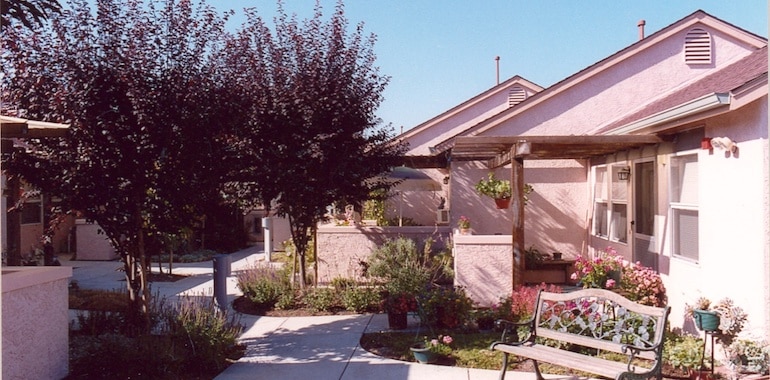As you age, your living arrangements can become a tricky subject to navigate. Exploring your retirement living options may seem intimidating, but it doesn’t have to be. Whether you’re looking to stay in your current home, downsize to a smaller place, or move into one of the independent living communities, it’s essential to take the time to explore your options and make the best decision for your future. Knowing your options and what you need to consider is the first step toward finding the best living situation.
Staying in Your Own Home
If you choose to stay in your home and age in place, there are several things to consider. First, you’ll want to evaluate your lifestyle and daily habits to see if they may create any issues for you in your home.
Are you able to navigate your home easily? If not, it may be worth considering whether modifications could make it safer and more accessible. Simple changes, such as installing handrails in critical areas or removing tripping hazards, can make a significant difference. Additionally, if you have mobility issues, you might need to evaluate whether your home is equipped with features like ramps or wider doorways.
Do you need assistance with day-to-day tasks? As you age, tasks that were once routine may become more challenging. If you find yourself struggling with cleaning, cooking, or personal care, you might want to explore in-home care services. These services can provide help with everything from housekeeping to personal assistance, allowing you to remain in your familiar environment while receiving the support you need.
Are you able to do the upkeep and maintenance on your home? Maintaining a home can become increasingly challenging as you age, particularly if you have health issues or mobility concerns. Regular upkeep tasks such as lawn care, cleaning gutters, and minor repairs might become more difficult over time. It’s important to assess whether you’re able to handle these responsibilities yourself or if you would benefit from hiring professionals to manage them.

Moving in with Family
Among the various retirement living options, moving in with family could be suitable if you’ve outgrown your current living situation but cannot afford assisted living. While it’s an option that many seniors consider, it’s essential to know that there are challenges that come with this type of living arrangement.
First, consider your relationship with the family member. Ideally, you’d be on good terms with them, and the relationship would be strong enough to overcome any challenges that arise from moving in together. Open communication is crucial to ensure that everyone is comfortable with the arrangement and that any potential issues can be addressed proactively.
Another hurdle to consider is adjusting to a new environment, especially if you’ve been living on your own for a long time. Transitioning from independent living to living with family can be a significant change, and it may take time to adapt to a new routine and shared space. If you’re concerned about adjusting to a new living situation with family, you may want to explore other retirement living options that offer more independence while still providing the support you need.
Low-Income Retirement Living Options
Low-income senior housing is specifically designed for senior citizens who have limited financial resources. These housing developments may be owned and managed by non-profit organizations, government entities, or private companies.
One of the key features of low-income retirement living options is that they often offer reduced rent or other financial assistance to help make the housing more affordable. This assistance is generally based on the resident’s income and may be provided through federal programs such as Section 8 or state or local programs.

Low-income retirement living options can take many forms, including:
- Apartments These may be in a complex or building specifically designed for low-income senior citizens. They often include amenities like community rooms and social activities to foster a sense of community.
- Single-family homes These may be in a community specifically designed for low-income senior citizens, offering more privacy while still providing access to community services and activities.
- Congregate housing This type of housing includes a shared living space with common amenities and shared meals, and may also include health and wellness services. It’s ideal for seniors who enjoy a social atmosphere and communal living.
- Supportive housing This type of housing includes support services such as meals, transportation, and health care for low-income senior citizens with disabilities or chronic health conditions. It offers additional assistance to ensure that residents’ needs are met comprehensively.
It’s important to note that the availability of low-income senior housing may vary depending on the location and demand. Check with HUD or local government housing authorities or non-profit organizations for more information and assistance in finding low-income retirement living options.
Retirement Communities
Retirement communities are often an excellent option for retirees who may be dealing with health issues or who don’t have family nearby. There are currently over 48,000 retirement communities in the US, with Florida being the most popular place to retire in the US.
Retirement communities are self-contained living environments that provide residents with a wide range of amenities, including housing, meals, healthcare, and social activities. These communities are designed to cater to various needs and preferences, making them a versatile choice for many retirees.
You can find retirement communities in rural and urban settings, which vary significantly in price to meet your budget and needs. Some retirement communities offer a range of lifestyle options, from independent living to assisted living and memory care. This flexibility allows you to choose a community that aligns with your current needs and future plans.
It’s essential to research all your retirement living options before choosing a retirement community to ensure it’s a good fit for you. Visit multiple communities, ask questions about the amenities and services offered, and speak with current residents to get a sense of the environment and quality of life.

Assisted Living Facilities
Assisted living facilities, a popular choice among retirement living options, provide 24/7 care for seniors who need assistance with daily tasks but don’t require hospital or nursing home care. They offer an excellent compromise for independent living without the hassle of chores and property maintenance.
Assisted living facilities offer housekeeping, meal preparation, and medication management services. These facilities are designed to support residents in maintaining their independence while providing necessary assistance with daily activities. The level of care and services can vary widely, so it’s important to thoroughly research options and visit potential facilities.
When evaluating retirement living options, particularly assisted living facilities, consider factors such as the staff-to-resident ratio, the quality of care provided, and the range of amenities available. Some facilities offer specialized care for individuals with specific needs, such as memory care for those with dementia.

Whether you decide to stay in your own home, move in with family, or choose a different living situation, understanding your retirement living options is crucial. Each option comes with its own set of benefits and challenges, and what works best for one person may not be ideal for another. It’s essential to consider factors such as your health, mobility, financial situation, and personal preferences. By thoroughly researching and evaluating these options, you can make an informed decision that ensures your comfort, safety, and happiness in your golden years.
With the correct information, you’ll be able to make the best decision for yourself and your loved ones. Take the time to visit potential living arrangements, speak with current residents, and consult with professionals if needed. Discuss your plans with family members to ensure everyone is on the same page and to gather their support. Evaluating your needs and preferences will help you find the living arrangement that best supports your lifestyle and well-being during your retirement years. Remember, the goal is to find a place where you can thrive and enjoy this new chapter of your life to the fullest.





